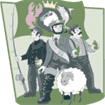 “Soldiers Riot in Calgary” (Retrieved form the New York Times)
“Soldiers Riot in Calgary” (Retrieved form the New York Times)
Shortly after prohibition came to Calgary in 1916, the city was the site of a violent uprising. A strong military presence in the city, coupled with a fundamental change to the social fabric of the city, made for explosive conditions. On the evening of October 11, 1916, men from the 211th, 218th and 233rd Battalions of the Canadian Expeditionary Forces assembled at the CP Rail Station on 9th Avenue and began to march on the police headquarters downtown. Their goal was to have members of their battalion, who had been imprisoned due to liquor offences, released. Violence erupted when their demands were not met.
 Women’s Christian Temperance Union (Retrieved from the Glenbow Museum)
Women’s Christian Temperance Union (Retrieved from the Glenbow Museum)
At the onset of the First World War, the Temperance Movement in Canada was reaching its peak. Groups such as the Women’s Christian Temperance Union believed alcohol to be the main source of social strife, causing everything from crime to domestic violence, and being responsible for poverty and disease. When war broke out, the temperance movement was furthered by claims that alcohol hindered the war effort. Temperance adherents advocated for dry military camps and training grounds. There was a fear that women and wives would not send their sons and husbands to war if there was going to be drinking. As the war went on, women at home were horrified by the rum ration and tales of drunken soldiers carousing in the villages and towns of Europe. Delegations of temperance advocates met with Prime Minister Robert Borden to warn him of the dangers of allowing alcohol in the military. Borden was told tales of women refusing to allow their sons to enlist. While those on the home front, quite disconnected from the horrors of war, believed they were helping, the soldiers were often enraged at the meddling.
The rum ration, part of military tradition for many years, kept many soldiers going and gave them a glimmer of hope in an otherwise desolate and savage environment. The overwhelming sentiment among soldiers was that the civilians back at home couldn’t possibly understand what those at the front were going through, and that should the roles be reversed, those favoring temperance would almost certainly change their minds.
 Sergeant Harold Baldwin (Source not Available)
Sergeant Harold Baldwin (Source not Available)
Harold Baldwin, in his 1918 memoirs ‘Holding the Line’ writes viciously of those who would seek to remove drink from the few small pleasures afforded to those at the front; “Oh you psalm-singers, who raise your hands in horror at the thought of the perdition the boys are bound for, if they should happen to take a nip of rum to keep in little warmth in their poor battered bodies. I wish you could all lie shivering in a hole full of icy liquid, with every nerve in your body quivering with pain, with the harrowing moans of the wounded forever ringing in your ears, with hell’s own din raging all around. Any one of you would need a barrel of it to keep his miserable life in his body.”
As men contended with the lice, blood, boredom and ever present terror of the battlefields and trenches, it was excruciatingly difficult to keep up morale. Many who were at the front, and who were temperance advocates before the war, changed their minds upon return.
The violence in Calgary even made The New York Times. Alberta repealed prohibition in 1924.
This blog is part of a series created to compliment our Downtown Through the Decades program on the Downtown Summer Stage. Each weekly performance runs from 1pm – 4pm on Saturdays on Stephen Avenue, and highlights a popular musical genre from a specific decade in Calgary’s history.
*The last performance is Saturday September 1, 2018.
Related Posts
| Tweet |
|



